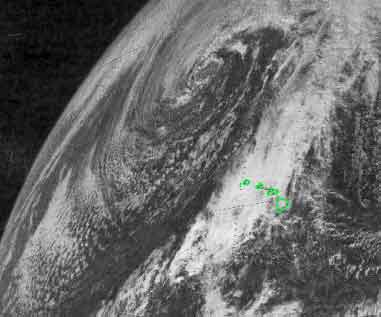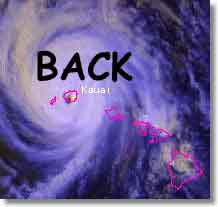WEATHER PATTERNS from LOWS WITHOUT FRONTS
Low pressure systems without fronts include Kona Storms and Tropical Depressions, Storms, and Cyclones. These potentially hazardous storms form in the tropical air mass and thus do not bring warm and cold air into contact: hence, no fronts. They are simply counterclockwise (cyclonic) circulations whose wind movements are the opposite of those produced under by High pressure centers. Vertical air movement is also opposite, with air rising along the Low pressure ridge. As air rises it cools, clouds form, and heavy rainfall and flooding are possible. Unlike High pressure centers which generally have very light winds (Kona Weather), Low pressure centers may experience extremely high wind speeds, which is why sailors prefer to avoid centers of either system.

Kona Storms: FORECAST: Overcast skies, with occasionally heavy rainfall affecting all islands, highs in the upper 70's lows in the mid-60's, southerly winds gusting to 35 mph. Kona Storms, or Kona Lows, may form in winter (October through April) from the tail end of a dying midlatitude Low (as shown in the satellite image above) or an upper troposphere disturbance. These rare events are odd weather creatures (classified as cold-core lows), wandering slowly, on often unpredictable paths, and lingering for a week or more at times. Winds may be strong or light. Rainfall may be continuous or intermittent although skies are generally completely overcast. In severe cases, kona lows have caused terrible weather, including hailstorms, thunder and lightening, waterspouts, torrential rains, high surf, and flooding. Generally, the rainiest weather occurs when the Low forms to the west of the islands as in the image above. If the Low forms east of the Islands, the rain may miss Hawaii altogether but winds may be strong. Kona Lows should not be confused with Kona Weather, which refers to generally clear skies, hot and humid conditions, and light and variable winds, often from the southwest.
Exercise: In the diagram to the left, click on the Low pressure center, hold the mouse down and drag the system around to see how winds change over the Islands depending on location.
To simulate a rainy Kona Low, move the Low to the west (W) of the Islands. What is the wind direction over Hawaii? What is the wind direction when the Kona Low is east (E) of the islands?
To simulate a typical tropical depression, move the Low up the island chain from right to left, either to the north or south of the islands. How do the winds change over the islands as the depression moves up the Island chain? To simulate the path of Hurricane Iniki (1992), move the Low slowly from south to north directly over the island of Kauai. What was the wind direction over Kauai before the center of Iniki hit the island? What was the wind direction after Iniki moved to the north? If a hurricane passed over Oahu, what would the wind direction be over Kauai? Over Maui?
Tropical Lows: FORECAST: Find shelter! Winds gusts to over 100 mph, torrential rainfall, extremely high surf and storm surge are possible. Hawaii's most devastating storms, hurricanes, are infrequent but may affect the Islands from June though mid-November. Under favorable conditions, these intense storms can strengthen to form the familiar spiral cloud bands and central eye. The most intense weather occurs near the eye wall, and hurricane force winds are generally confined to a 50 mile radius. Tropical Depressions (up to 38 mph winds) and Tropical Storms (38 to 73 mph winds) affect the island much more frequently than hurricanes, either representing dying hurricane systems or low pressure centers that did not strengthen into hurricane force. These systems move from east to west over the Islands with the trade winds and can bring heavy rainfall and thunderstorms in summer as they temporarily displace the inversion.
